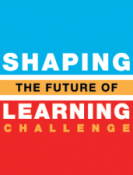
December 5-6, 2014
Barrie School, Silver Spring, MD
Over 130 learners and designers of all ages spent two days shaping and designing the future of learning. Congratulations to Team Learners on winning for their prototype model of a Google Glass-augmented 3D-printed animal dissection lab!
#FIAumd #ShapeLearning
Challenges
These challenges served as inspiration for what the teams might work on, or they could chose to create their own. Teams were allowed to build low-tech prototypes, make a video, present a vision paper, develop software, create a website — anything that demonstrated their idea. Teams were instructed to share their ideas in a way that the judges would understand how innovative their idea was, how much impact it might have, and how feasible it might be to implement.
Education experts were on-hand to help teams as they worked on their ideas. More Info »
Real-World Engagement
Digital mobile technologies can enhance learning and exploration in the classroom, but outside of the classroom, non-learning apps can become the focus for students using mobile devices. How can we encourage students to use their mobile technology for real-world and self-directed learning and exploration at home?
Possible ideas for engaging students with learning and exploration:
- Applications requiring interaction with other students to achieve an in-app goal
- Location-dependent access to digital content
- Encouraging self-directed exploration by presenting related content to what is assigned in schools
- Use virtual reality to let kids learn about history in a fun way wherever they are
Resources
- Mobile devices for learning: What you need to know (edutopia, pdf download requires email address to be entered)
- Using the technology of today in the classroom today (The Education Arcade, MIT)
- Connected learning infographic (MacArthur Research Network on Connected Learning)
- Is technology sapping children’s creativity? (Washington Post)
- Authentic learning for the 21st century: An overview (Educase Learning Initiative)
Transferring Non-Digital Experiences
Writing to a pen pal used to be a common way for students from across the globe to get to know each other and learn about different cultures and practice different languages. How can we replicate the experience of sending and receiving handwritten letters and other small items via snail mail using our current technologies?
Possible ideas for transferring non-digital experiences:
- An application that allows the use of a stylus to write letters and preserves handwriting even when translated to another language
- An application that enables the collection of digital artifacts (e.g. a “movie ticket” from watching a YouTube video) from websites or other apps to send to others
Resources
- Pen pal (Wikipedia)
- Pen pals in the 21st century (edutopia)
- Want a robot pen pal? (New York Times)
- The allure of an old-fashioned pen pal (BBC News)
- Postcrossing
Digital images of primary sources — such as letters, photographs, maps, drawings, as well as sound and video recordings — have become more accessible, but more still needs to be done to increase their use by students and teachers.
Possible ideas for better engaging students and teachers with primary sources include:
- applications that allow users to create content using primary sources
- websites that encourage exploration of primary source collections
Resources
- Primary Source Sets (Library of Congress)
- Student Discovery Sets (Library of Congress)
- Resources for Teaching American History (Smithsonian)
- Primary Sources for Teachers and Students (National Archives)
- Newseum Digital Classroom Primary Sources (Newseum)
Place-Based Learning
Artifacts in museums, national parks, and historic locations are often accompanied by short descriptive signs, but the signs only tell a fraction of the story. Those interested in learning more are usually referred to a web site or some other reference source that they can view later. How can we facilitate a more comprehensive learning experience that provides rich media content when people are most interested?
Possible ideas for place-based learning:
- create a proximity app that provides rich media content to visitors at a museum, national park, or other location
Resources
- iBeacon (if interested, an iBeacon system can be provided by the Newseum; contact Paul Sparrow before the event for more information)
Equitable Access
As learning becomes more technology focused, what happens to learners worldwide who do not have access to personal technology devices or perhaps even electricity? How will the future promise of education be fulfilled without these populations?
Possible ideas for providing equitable access:
- free or publicly funded access to learning at central locations outside of schools (e.g. public libraries, health centers, or stores)
- inexpensive and transportable devices with solar charges, satellite access
- ilearning experiences integrated with everyday needs (e.g. children working on family farms)
Resources
- Education Gap Grows Between Rich and Poor, Studies Say (The New York Times)
- The Widening Academic and Achievement Gap Between the Rich and the Poor (Center for Education Policy Analysis)
- Ethnic and Racial Minorities Socioeconomic Status (American Psychological Association)
- Digital Inclusion (American Library Association)
- IEP Stats (National Center for Education Statistics)
- The Role of Public Libraries in Children’s Literacy Development (Pennsylvania Library Association)




